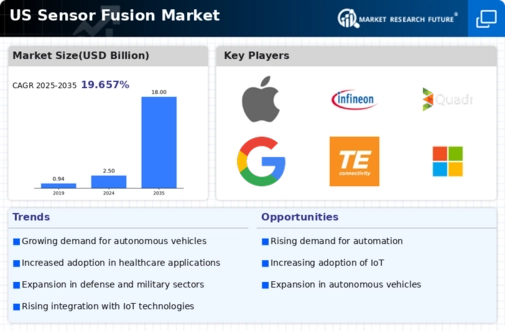Increased Focus on Smart Cities
The development of smart cities is emerging as a significant driver for the sensor fusion market. As urban areas strive to enhance infrastructure, transportation, and public services, sensor fusion technologies are being utilized to optimize resource management and improve quality of life. For instance, integrating data from traffic sensors, environmental monitors, and public safety systems can lead to more efficient urban planning and real-time responses to city challenges. The US government has allocated substantial funding for smart city initiatives, with investments expected to exceed $100 billion by 2025. This financial commitment indicates a strong market potential for sensor fusion solutions that can support the complex data integration required in smart city applications. Consequently, the sensor fusion market is likely to benefit from this trend as cities increasingly adopt advanced technologies to address urbanization challenges.
Emergence of Wearable Technology
The rise of wearable technology is significantly impacting the sensor fusion market, as these devices increasingly rely on integrated sensor systems to deliver enhanced functionality. Wearables, such as fitness trackers and smartwatches, utilize sensor fusion to combine data from accelerometers, gyroscopes, and heart rate monitors, providing users with comprehensive health and activity insights. The US wearable technology market is expected to surpass $60 billion by 2025, indicating a robust demand for sensor fusion solutions that can support these applications. This growth is likely to drive innovation in sensor fusion technologies, as manufacturers seek to improve accuracy and user experience. The integration of multiple sensors allows for more precise tracking and monitoring, thereby propelling the sensor fusion market as wearables continue to gain popularity among consumers.
Rising Demand for Autonomous Systems
The sensor fusion market is experiencing a notable surge in demand driven by the increasing adoption of autonomous systems across various sectors. Industries such as automotive, robotics, and drones are integrating sensor fusion technologies to enhance navigation, perception, and decision-making capabilities. In the automotive sector alone, the market for autonomous vehicles is projected to reach $60 billion by 2030, with sensor fusion playing a critical role in ensuring safety and efficiency. This trend indicates a robust growth trajectory for the sensor fusion market, as companies strive to develop advanced systems that can operate independently in complex environments. The integration of multiple sensor modalities, including LiDAR, radar, and cameras, is essential for achieving the high levels of reliability required in autonomous applications. As a result, the sensor fusion market is likely to expand significantly in response to these evolving technological demands.
Advancements in Internet of Things (IoT)
The proliferation of the Internet of Things (IoT) is significantly influencing the sensor fusion market. As more devices become interconnected, the need for sophisticated data processing and analysis increases. Sensor fusion technologies enable the aggregation of data from various IoT devices, providing comprehensive insights and enhancing operational efficiency. In the US, the IoT market is expected to grow to $1.1 trillion by 2026, with sensor fusion being a pivotal component in managing the vast amounts of data generated. This growth is likely to drive innovation in sensor fusion solutions, as companies seek to leverage real-time data for improved decision-making and automation. The ability to combine data from diverse sources allows for more accurate predictions and smarter systems, thereby propelling the sensor fusion market forward in the context of IoT advancements.
Growing Demand for Enhanced Security Systems
The sensor fusion market is witnessing a growing demand for enhanced security systems, particularly in the context of surveillance and threat detection. As security concerns escalate, organizations are investing in advanced technologies that can provide comprehensive situational awareness. Sensor fusion plays a crucial role in integrating data from various security sensors, such as cameras, motion detectors, and alarms, to create a unified security framework. The US security market is projected to reach $100 billion by 2027, with a significant portion attributed to sensor fusion technologies. This trend suggests that businesses and government entities are increasingly recognizing the value of multi-sensor systems in improving security measures. As a result, the sensor fusion market is likely to expand as organizations seek to implement more sophisticated and reliable security solutions.






















Leave a Comment